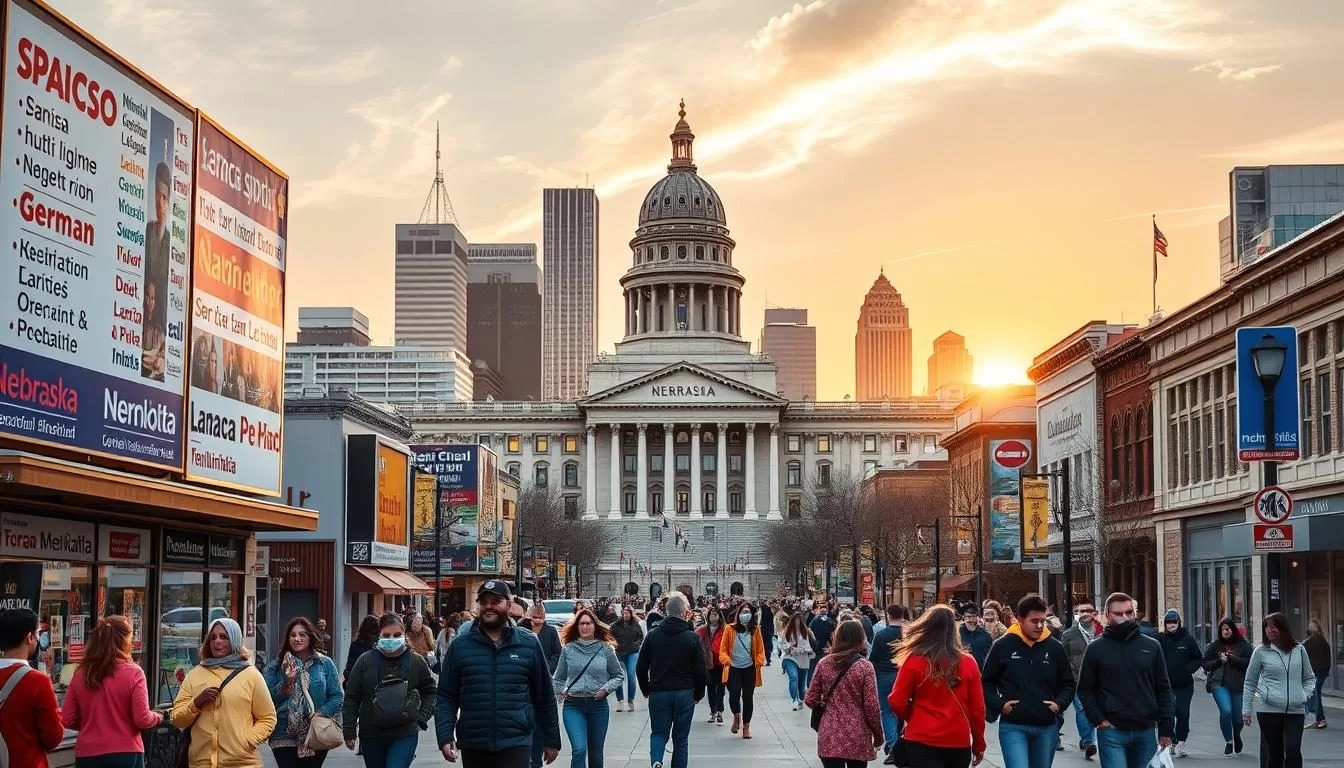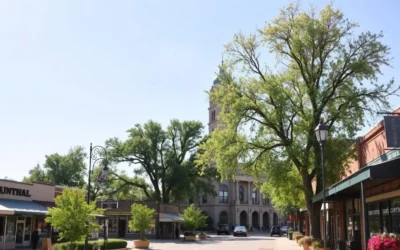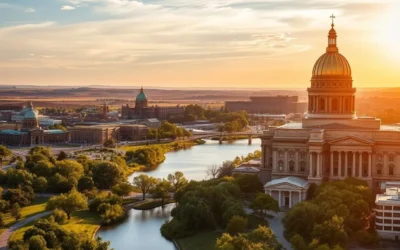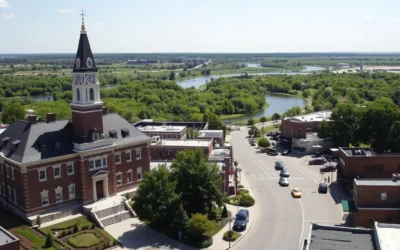✓ Accommodations✓ Flights✓ Rental Cars
You’re about to explore the diverse linguistic landscape of Nebraska, a state that mirrors the broader language diversity seen across the United States. As you delve into the Cornhusker State’s language demographics, you’ll discover the fascinating array of languages spoken within its borders.
Data reveals that Spanish is the most widely spoken non-English language in Nebraska, with approximately 7.36% of the population speaking it at home. This is followed by Vietnamese, Arabic, and Chinese, showcasing the state’s diverse cultural heritage.
As you explore further, you’ll gain insights into the languages that are officially recognized and those that are most commonly spoken throughout the state. Understanding Nebraska’s linguistic makeup helps appreciate the state’s cultural diversity and heritage.
The Linguistic Landscape of Nebraska
As you explore the linguistic landscape of Nebraska, you’ll discover a diverse tapestry of languages spoken across the state. According to census data, the population’s language use at home is varied, reflecting the state’s cultural diversity.
Nebraska’s linguistic diversity is evident in the data on language use. You can see that languages other than English are spoken by a significant portion of the population. Specifically, 7.36% of Nebraska’s population speaks Spanish at home, while smaller percentages speak Vietnamese (0.45%), Arabic (0.30%), Chinese (0.28%), German (0.26%), and French (0.25%).
Nebraska’s Language Demographics
The state’s language demographics show that Spanish is the dominant non-English language, spoken by approximately 128,899 Nebraska residents. You’ll find that the communities in Nebraska are linguistically diverse, with various immigrants contributing to the state’s cultural fabric.
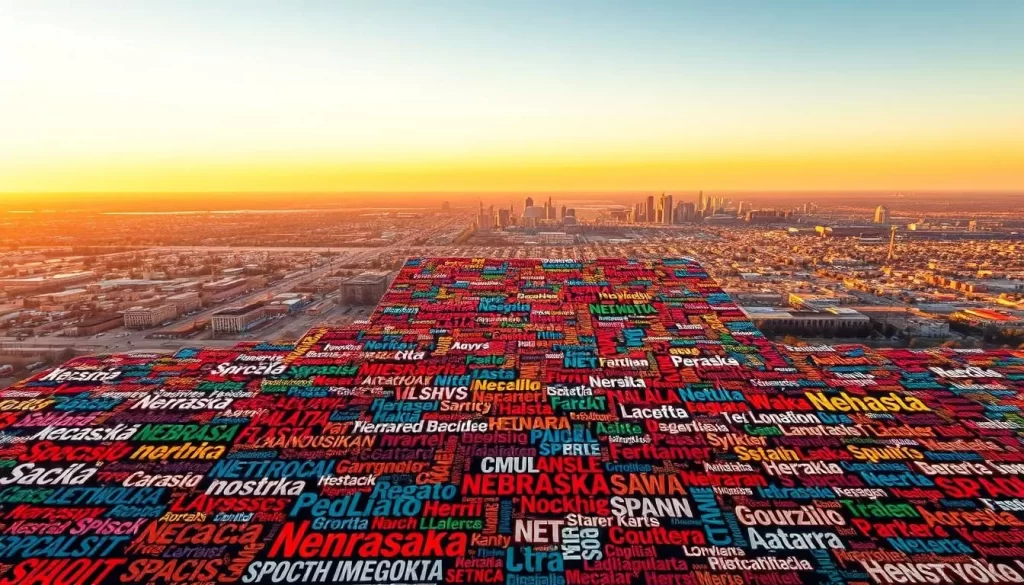
Historical Context of Languages in Nebraska
The historical context reveals how immigrants from various countries, particularly Germany, played a major role in shaping Nebraska’s linguistic landscape. German was historically more prevalent due to significant German immigration in the 18th and 19th centuries. You’ll discover how Nebraska’s position in the American heartland has made it a destination for various immigrant groups throughout its history, contributing to the U.S. state‘s linguistic diversity.
Understanding the state’s linguistic demographics helps explain cultural patterns and community formations across Nebraska. You’ll see how Nebraska’s language diversity reflects broader patterns of immigration and settlement in the United States.
English as Nebraska’s Primary Language
You will find that English is deeply ingrained in Nebraska’s culture and daily life. While Nebraska doesn’t have an official state language by law, English functions as the de facto official language in government, education, and business.
The historical development of English as Nebraska’s primary language reflects the state’s settlement patterns and cultural evolution. As the predominant language, English plays a crucial role in shaping the state’s identity and facilitating communication among its residents.
The English-Only Movement in Nebraska
The English-Only movement has gained traction in Nebraska as part of a broader national trend. Proponents argue for official English status, emphasizing the importance of a common language for social cohesion and national unity. This movement reflects the complexities surrounding language policy and the role of English in American society.
English Usage Statistics
Over 85% of Nebraska residents speak English at home, placing it above the national average for English usage. The data reveals interesting patterns about English proficiency across different language communities in Nebraska. For instance, among Spanish speakers, 46.1% report speaking English less than “very well,” while for Vietnamese speakers, the figure is 63.1%. Understanding these statistics is crucial for addressing the needs of non-native English speakers in the state.
As you delve deeper, you’ll understand how English proficiency impacts educational outcomes, employment opportunities, and social integration for non-native speakers in Nebraska. The state’s English usage statistics also provide a comparison with neighboring states and national trends, offering insights into the linguistic diversity of the region.
Nebraska, United States: Official and widely spoken languages
As you explore the linguistic landscape of Nebraska, you’ll discover a diverse array of languages spoken across the state. This diversity reflects the state’s cultural heritage and the various communities that have made Nebraska their home.

Spanish: The Most Common Non-English Language
You’ll find that Spanish is the most common non-English language in Nebraska, spoken by 7.36% of the population, which translates to approximately 128,899 people. The Spanish-speaking community has grown significantly in recent decades, particularly in areas with meatpacking and agricultural centers.
The presence of Spanish is evident in many aspects of life in Nebraska, from cultural events to language services provided by various institutions.
Vietnamese and Chinese Communities
Nebraska is also home to vibrant Vietnamese and Chinese communities. The Vietnamese community began forming after the Vietnam War and continues to grow today. You might notice the presence of Vietnamese cultural centers and businesses, particularly in urban areas like Omaha.
The Chinese-speaking population is primarily concentrated in university towns and urban centers, reflecting both academic and economic migration. This community contributes to the state’s linguistic diversity.
Arabic and Other Significant Languages
The Arabic-speaking community in Nebraska represents diverse origins from across the Middle East and North Africa. You’ll find that this community has expanded in recent years, adding to the state’s language diversity.
Other significant language groups in Nebraska include German, French, and various Asian languages. These communities have established cultural centers, businesses, and religious institutions, enriching the state’s cultural landscape and reflecting the diversity of the people who live there.
The geographic distribution of these language communities throughout Nebraska reveals interesting patterns of settlement and community formation. As you explore the state, you’ll see how these communities have made Nebraska a more diverse and vibrant place to live.
Indigenous and Historical Languages of Nebraska
As you explore the linguistic heritage of Nebraska, you’ll discover a rich tapestry of indigenous and historical languages. The state’s linguistic landscape has been shaped by the presence of Native American communities and the influence of European settlers.
Native American Languages in Nebraska’s History
Before European settlement, numerous indigenous languages were spoken in the Nebraska territory, including languages from the Siouan family, such as Dakota and Omaha-Ponca. These languages played a significant role in the pre-colonial linguistic landscape.
The impact of European colonization on indigenous languages was dramatic, leading to the decline of many native tongues. However, in recent decades, certain indigenous languages have experienced revitalization efforts.

German Heritage and Language Influence
German settlers formed substantial communities in Nebraska during the 19th century, establishing German-speaking enclaves throughout the states. The German language and culture significantly influenced Nebraska’s development, from place names to cultural traditions that persist today.
| Language Family | Historical Significance | Current Status |
|---|---|---|
| Siouan | Primary language family for many Native American tribes | Efforts underway to revitalize and document the languages |
| German | Influential due to 19th-century immigration | Declined due to historical suppression, but still present in cultural heritage |
Comparing Nebraska’s historical language patterns to those of neighboring states like North Dakota and South Dakota reveals interesting regional variations. Understanding these patterns provides insight into the complex linguistic history of the region.
English Proficiency Among Nebraska’s Language Communities
English proficiency varies significantly among Nebraska’s language communities, impacting education, healthcare, and employment. As the state’s linguistic diversity continues to grow, understanding the nuances of English proficiency is crucial for addressing the needs of its residents.
Language Barriers and English Fluency Rates
The data indicates that among Nebraska’s non-English speakers, proficiency levels vary significantly. For instance, 46.1% of Spanish speakers report speaking English less than “very well,” while the figure is 63.1% for Vietnamese speakers and 60.1% for Chinese speakers. These statistics highlight the need for targeted language access services in the state.
Language barriers can have significant implications for daily life, affecting areas such as healthcare, education, and employment opportunities. As a result, it’s essential to understand the scope of language barriers and the resources available to address them.
| Language Group | Percentage Speaking English Less Than “Very Well” |
|---|---|
| Spanish | 46.1% |
| Vietnamese | 63.1% |
| Chinese | 60.1% |
Language Access Services in Nebraska
Nebraska has implemented various language access services to assist those with limited English proficiency. These services include interpretation and translation in healthcare, government services, and education. The state’s educational institutions have also developed ESL programs to address the needs of students from non-English speaking homes.
By providing these services, Nebraska aims to bridge the gap for residents facing language barriers, ensuring they have equal access to essential services and opportunities. As the state’s linguistic diversity continues to evolve, the importance of comprehensive language access policies becomes increasingly clear.

Conclusion: Nebraska’s Evolving Linguistic Diversity
As we conclude our exploration of Nebraska’s linguistic landscape, it’s clear that the state’s language demographics are shaped by its history and immigration patterns. You’ve gained a comprehensive understanding of Nebraska’s linguistic landscape, from its historical roots to its present-day diversity. The state’s linguistic diversity, while not as vast as that of states like New York or California, reflects the broader patterns of immigration and settlement in America’s heartland.
Nebraska maintains English as its primary language while hosting a variety of other languages, with Spanish being the dominant non-English language. The Vietnamese, Arabic, and Chinese communities continue to grow, enriching the state’s cultural landscape. Understanding Nebraska’s linguistic diversity is essential for appreciating its cultural heritage and planning for its future.
The evolution of languages in Nebraska continues, with new immigrant communities adding to the state’s cultural and linguistic tapestry. As you consider the future, it’s clear that language access services and English language learning opportunities will play a crucial role in ensuring all Nebraska residents can fully participate in society. Nebraska’s linguistic diversity mirrors the broader linguistic diversity seen across the United States, where over 350 languages are spoken.
The above is subject to change.
Check back often to TRAVEL.COM for the latest travel tips and deals.
